Properties
Winston Gold and Silver Project
Foremost Lithium’s Winston Group of Properties is a Gold and Silver Project on its 3000-acre drill-ready property located in the Black Range of Sierra County, New Mexico. It's home to three historic mines; Ivanhoe, Emporia, and Little Granite consisting of 147 unpatented BLM (Bureau of Land Management) mining claims and 2 patented Ivanhoe and Emporia lode mining claims. Each mine produced high-grade gold and silver during full-time operations over a century ago, underscored by Little Granite producing high value ore in some of its underground shoots.
Figure. 1 - Location of the Winston Property Winston, New Mexico
2021 Winston Property Sampling and Exploration
Michael Feinstein, CPG, QP, has visited the Winston Project area on ten separate occasions since October 2020 where he conducted confirmatory sampling of the known historic mines, as well as prospecting away from the known occurrences. All samples were collected under his direct supervision of and securely transported to the Tuscon laboratory of the ALS Global for analysis. It confirmed the occurrence of high-grade material at all three of the historic mines, but also in some locations away from these areas. These were deemed a great success and produced many high-grade samples including g 41.5 g/t Gold and 4610 g/t Silver on newly staked claims, which before no modern exploration efforts have systemically assessed the northern portion of the Chloride District. Additional samples from these three mines returned peak values of 66.5 g/t gold and 2940 g/t silver from Little Granite, 26.8 g/t gold and 1670 g/t silver from Ivanhoe, and 46.1 g/t gold and 517 g/t silver from Emporia.
*Highest Grade Sample From Each Mine
| Mine | Au_ppm | Ag_ppm |
| Little Granite | 66.5 | 2,940 |
| Ivanhoe | 26.8 | 940 |
| Emporio | 44.9 | 517 |
| Prospecting Best | 41.5 | 4,610 |

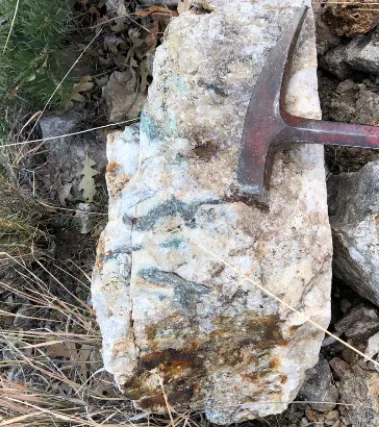
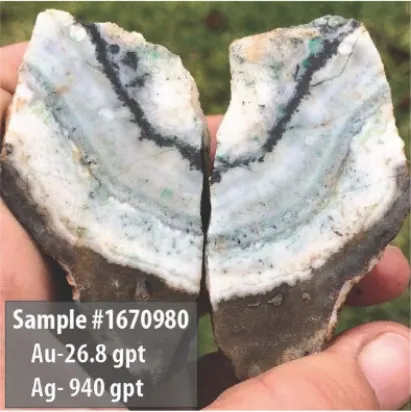
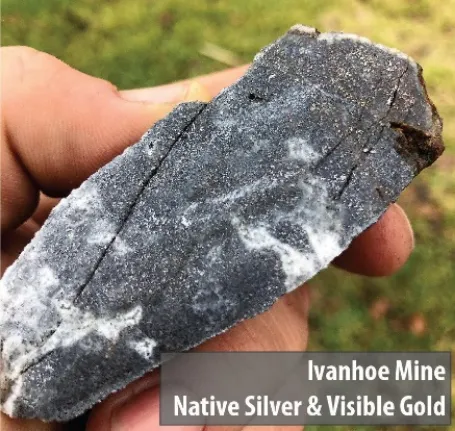
Project Highlights
- The project has contiguous landholdings totaling approximately 147 claims covering almost 3,000 acres. Claims are targeted along footprint of mineralization extending for more than 8 km of strike.
- Drill-ready targets on patented claims
- Historic drilling in early 1980s suggests potential for high-grade ore shoots within larger mineralized envelopes. The Chloride District saw a rush of miners and prospectors in the 1860s-1890s, a period of renewed mining activity in the 1980s, and has been largely unexplored by modern methods.
- Potential for District-Scale discovery in a Precious Metal Endowed Low-Sulphidation Epithermal Vein System.
- Ground geological mapping and surveying has utilized high resolution satellite imagery and LiDAR (laser-generated infrared light beams) to construct a detailed digital model of the area. This 3D GIS will be used for all drill targeting and project planning. Special attention will be given to maintaining a high level of vertical accuracy due to the local topography.
Exceptional results from property-wide confirmatory sampling completed in 2021 include:
Measured width Highlights:
- 3.35 g/t Au with 245 g/t Ag from a 0.3m channel sample inside the Little Granite Decline.
- 1.97 g/t Au with 232 g/t Ag from a 0.3m channel sample across JAP vein at LG mine.
- 29.2 g/t Au with 462 g/t Ag from a 0.6m continuous chip sample in north zone.
- 3.2 g/t Au with 34 g/t Ag from a 1.0m continuous chip sample in north zone
- 0.75 g/t Au with 489 g/t Ag from a 0.3m continuous chip sample in north zone.
Prospecting Highlights:
- Sample 1671079 collected at a prospect pit in recently staked ground returned 41.5 g/t Au with 4,610.0 g/t Ag.
- Samples 1671021, 1671024, 1671027 were collected from the same vein trend over 300m of strike
- #1671021 returned 20.6 g/t Au with 21.0 g/t Ag.
- #1671024 returned 12.3 g/t Au with 381.0 g/t Ag.
- #1671027 returned 5.7 g/t Au with 254.0 g/t Ag.
For the 155 samples across the project, gold values range from Below Detection (BD; <0.02 for Au) to a maximum of 66.5ppm, and Silver values range from BD (<0.02 for Ag) to a maximum of 4,610 g/t Ag.
Geological Setting of the Winston Project
The Winston Project, situated in the historic Black Range Mining District of southwestern New Mexico, covers 108 square kilometers of the northern portion of the Chloride District. High grade deposits of silver and gold were discovered in 1880 and the area was a major producer until the 1893 crash in the silver price. Little production or modern exploration has occurred since.
The mineralization is of the well-documented epithermal type, common throughout the Cordillera of North and South America and elsewhere around the Pacific Rim of Fire. There is a close association with volcanic host rocks formed at the same time as the mineralization. Individual mines and prospects generally show strong controlling geological structures, typically north-south high angle faulting associated with the Rio Grande Rift which extends for over 1200 kilometers from northern Mexico to central Colorado. On the Winston property, the main structure is the 25km long Paymaster Fault which is readily traced both on the ground using satellite and LiDAR imagery.
Alteration minerals associated with the precious metal mineralization at Winston have yielded radiometric age dates of around 26.5 million years. This coincides with a major volcanic event in the region and broadly correlates with the age of mineralization at the historic Creede Mining District in Southwestern Colorado, which has recorded production of over 84 million ounces of silver, worth in excess of $2 billion dollars US at current prices. Hecla Mining Corp., the premier US silver producer, is undertaking a major evaluation of mines in The Creede District which may lead to the area having a new
Little Granite Mine
The Little Granite Mine is a past-producing high-grade silver-gold mine hosted in Tertiary volcanics. The style of gold-silver mineralization in the region is known as epithermal, with the precious metal mineralization being hosted by quartz and carbonate veins in altered volcanic rocks. This style on mineralization is known world-wide and hosts some of the highest-grade gold-silver mines, such as Hishikari in Japan, Fruta del Norte in Ecuador and Midas in Nevada. Locally, the mineralized veins are generally associated with north-south trending faulting. The overall controlling geological feature is known as the Rio Grande Rift and extends into northern Mexico where it hosts to several past and present silver mines. The main vein has been traced for over 200 metres by past drilling and underground workings and remains open along strike to both the north and south, and at depth. Historically reported high grade values confirmed in limited resampling by Foremost Lithium in late 2013. Historic reports suggest vein widens to approx 3m (10ft) at depth.
Historically reported high-grade values were confirmed in limited re-sampling by Foremost in late 2020. Historic drill reports suggest the primary vein widens to more than 4m (12ft) true width, at depth.
Ivanhoe – Emporia Mines
The Ivanhoe – Emporia is a past producing gold-silver mine. It’s main shaft to 384 feet depth with a 370ft decline. Potential for large tonnage of lower grade, stockwork veins surrounding high grade veins mined the past. Soil geochemistry and geophysical anomalies defined for follow-up when funds available, as favorable structural conditions persist along the bends and jobs of this Paymaster Fault.
Past preparatory work for drilling has included data compilation both of historic and recent work, along with acquisition of high-resolution LiDAR satellite imagery to allow construction of an accurate terrane model. This was followed by geophysical surveying using both electrical and magnetic methods. This property had little to no modern exploration since the early 1980’s and with such high-grade samples returned, the investment community is eager to see drill results and the full potential from the Winston Gold/Silver project that has yet to be realized.
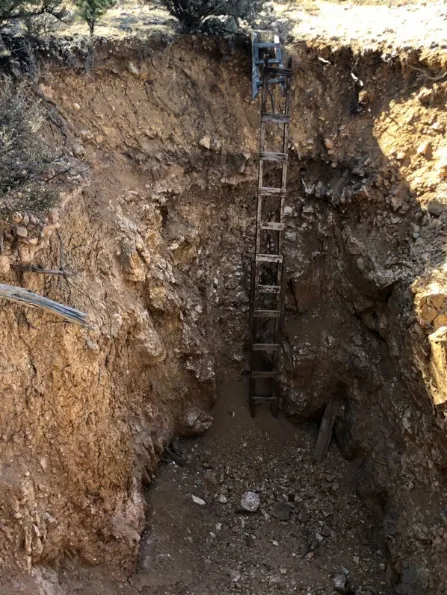

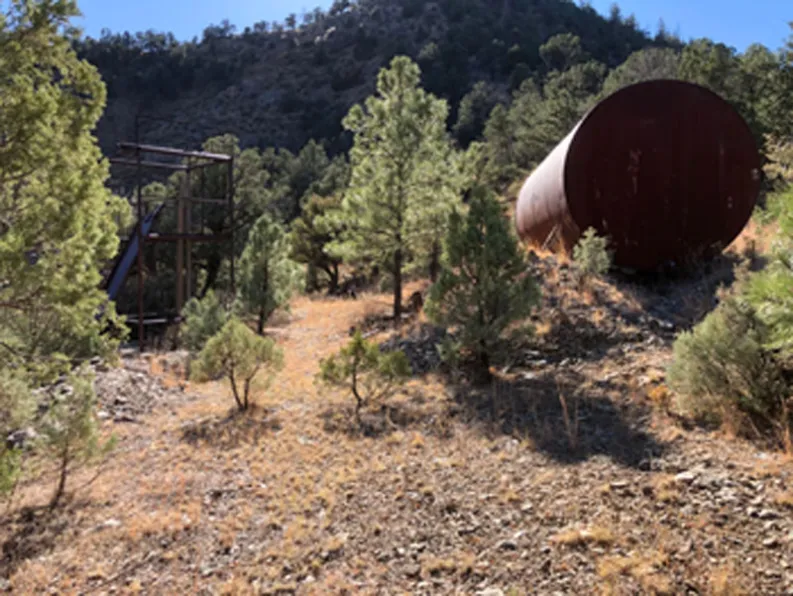
QA/QC Statement
166 samples have been processed by ALS Laboratories’ (“ALS”) for Precious Metals and Multi-Elements. All Foremost's (previously FAR Resources) rock sample assay results have been independently monitored through a quality assurance/quality control (“QA/QC”) protocol which includes the insertion of blind standard reference materials at regular intervals. Samples were maintained by Dr. Feinstein and securely transported to ALS sample preparation facilities in Tucson, Arizona and Reno, Nevada. Sample pulps were sent to ALS’s labs in Vancouver, Canada, for analysis.
All samples were of hard rock and prepared by fine crushing to 70% passing <2mm, riffle split, and then pulverization to 80% passing < 75 um (ALS Method Prep-31). Gold content was determined by fire assay of a 50-gram charge with ICP finish (ALS method Au-GRA22). Silver and 47 other elements were analyzed by ICP methods with four-acid digestion (ALS method ME-MS61). Over-limit samples for Ag, and Cu were determined by ore-grade analyses Ag-OG62, Cu-OG62, respectively.
ALS Laboratories is independent of Foremost and its Vancouver facility is ISO-17025 accredited. ALS also performed its own internal QA/QC procedures to assure the accuracy and integrity of results. Parameters for ALS’ internal and Foremost's external blind quality control samples were acceptable for the samples analyzed. Foremost is not aware of any sampling, or other factors that could materially affect the accuracy or reliability of the data referred to herein.
To read more about the Winston Property and its history please read the deck:
DOWNLOAD
QP Statement
Michael Feinstein, PhD, CPG, is the Qualified Person (Q.P.) responsible for the technical material contained in this document. All samples are collected and maintained in accordance with established QA/QC protocols. Samples were analyzed by Fire Assay and ICP-MS. Internal laboratory QA/QC protocols were followed and 5% external standards are submitted with all sample batches. The technical content of this news release has been reviewed by Dr. Michael Feinstein, CPG, who is a Qualified Person as defined by NI 43-101.

